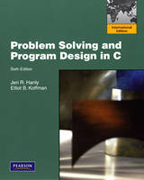
Problem Solving and Program Design in C is one of the best-selling introductory programming textbooks using the C programming language. It embraces a balanced approach to program development and an introduction to ANSI C. The book provides a gradual introduction to pointers and covers programming with functions early in the text. In later chapters, students learn to implement fundamental data structures such as lists, stacks, queues, and trees in a language that fosters their understanding of stack- and heap-dynamic memory allocation and programmer-controlled pointers. To enhance students' learning experience it offers the right amount of pedagogical features that include end-of-section and chapter exercises, examples and case studies, syntax and program style display boxes, error discussions and end-of-chapter projects. INDICE: CONTENTS 0. Computer Science as a Career Path 0.1 Why CS May be the Right Field for You 0.2 The College Experience: Computer Disciplines and Majors from Which to Choose 0.3 Career Opportunities 1. Overview of Computers andProgramming 1.1 Electronic Computers Then and Now 1.2 Computer Hardware 1.3 Computer Software 1.4 The Software Development Method 1.5 Applying the SoftwareDevelopment Method Case Study: Converting Miles to Kilometers Chapter Review 2. Overview of C 2.1 C Language Elements 34 2.2 Variable Declarations and DataTypes 2.3 Executable Statements 2.4 General Form of a C Program 2.5 Arithmetic Expressions Case Study: Supermarket Coin Processor 2.6 Formatting Numbers inProgram Output 2.7 Interactive Mode, Batch Mode, and Data Files 2.8 Common Programming Errors Chapter Review 3. Top-Down Design with Functions 3.1 BuildingPrograms from Existing Information Case Study: Finding the Area and Circumference of a Circle Case Study: Computing the Weight of a Batch of Flat Washers 3.2 Library Functions 3.3 Top-Down Design and Structure Charts Case Study: Drawing Simple Diagrams 3.4 Functions without Arguments 3.5 Functions with Input Arguments 3.6 Common Programming Errors Chapter Review 4. Selection Structures:if and switch Statements 4.1 Control Structures 4.2 Conditions 4.3 The if Statement 4.4 if Statements with Compound Statements 4.5 Decision Steps in Algorithms Case Study: Water Bill Problem 4.6 More Problem Solving Case Study: WaterBill with Conservation Requirements 4.7 Nested if Statements and Multiple-Alternative Decisions 4.8 The switch Statement 4.9 Common Programming Errors Chapter Review 5. Repetition and Loop Statements 5.1 Repetition in Programs 5.2 Counting Loops and the while Statement 5.3 Computing a Sum or a Product in a Loop 5.4 The for Statement 5.5 Conditional Loops 5.6 Loop Design 5.7 Nested Loops5.8 The do-while Statement and Flag-Controlled Loops 5.9 Problem Solving Illustrated Case Study: Collecting Area for Solar-Heated House 5.10 How to Debug and Test Programs 5.11 Common Programming Errors Chapter Review 6. Modular Programming 6.1 Functions with Simple Output Parameters 6.2 Multiple Calls to a Function with Input/Output Parameters 6.3 Scope of Names 6.4 Formal Output Parameters as Actual Arguments 6.5 A Program with Multiple Functions Case Study: Arithmetic with Common Fractions 6.6 Debugging and Testing a Program System 6.7 Common Programming Errors Chapter Review 7. Simple Data Types 7.1 Representation and Conversion of Numeric Types 7.2 Representation and Conversion of Type char 7.3 Enumerated Types 7.4 Iterative Approximations Case Study: Bisection Method for Finding Roots 7.5 Common Programming Errors Chapter Review 8. Arrays 8.1 Declaring and Referencing Arrays 8.2 Array Subscripts 8.3 Using for Loops for Sequential Access 8.4 Using Array Elements as Function Arguments 8.5 ArrayArguments 8.6 Searching and Sorting an Array 8.7 Multidimensional Arrays 8.8 Array Processing Illustrated Case Study: Summary of Hospital Revenue 8.9 Common Programming Errors Chapter Review 9. Strings 9.1 String Basics 9.2 String Library Functions: Assignment and Substrings 9.3 Longer Strings: Concatenation and Whole-Line Input 9.4 String Comparison 9.5 Arrays of Pointers 9.6 CharacterOperations 9.7 String-to-Number and Number-to-String Conversions 9.8 String Processing Illustrated Case Study: Text Editor 9.9 Common Programming Errors Chapter Review 10. Recursion 10.1 The Nature of Recursion 10.2 Tracing a Recursive Function 10.3 Recursive Mathematical Functions 10.4 Recursive Functions with Array and String Parameters Case Study: Finding Capital Letters in a String Case Study: Recursive Selection Sort 10.5 Problem Solving with Recursion Case Study: Operations on Sets 10.6 A Classic Case Study in Recursion: Towers of Hanoi 10.7 Common Programming Errors Chapter Review 11. Structure and Union Types 11.1 User-Defined Structure Types 11.2 Structure Type Data as Input and Output Parameters 11.3 Functions Whose Result Values Are Structured 11.4 Problem Solving with Structure Types Case Study: A User-Defined Type for Complex Numbers 11.5 Parallel Arrays and Arrays of Structures Case Study: Universal Measurement Conversion 11.6 Union Types (Optional) 11.7 Common Programming Errors Chapter Review 12. Text and Binary File Processing 12.1 Input/Output Files: Reviewand Further Study 12.2 Binary Files 12.3 Searching a Database Case Study: Database Inquiry 12.4 Common Programming Errors Chapter Review 13. Programming inthe Large 13.1 Using Abstraction to Manage Complexity 13.2 Personal Libraries: Header Files 13.3 Personal Libraries: Implementation Files 13.4 Storage Classes 13.5 Modifying Functions for Inclusion in a Library 13.6 Conditional Compilation 13.7 Arguments to Function main 13.8 Defining Macros with Parameters 13.9 Common Programming Errors Chapter Review 14. Dynamic Data Structures 14.1 Pointers 14.2 Dynamic Memory Allocation 14.3 Linked Lists 14.4 Linked List Operators 14.5 Representing a Stack with a Linked List 14.6 Representing a Queue with a Linked List 14.7 Ordered Lists Case Study: Maintaining an Ordered List of Integers 14.8 Binary Trees 14.9 Common Programming Errors Chapter Review 15.Multiprocessing Using Processes and Threads 15.1 Multitasking 15.2 Processes 15.3 Interprocess Communications and Pipes 15.4 Threads 15.5 Threads Illustrated Case Study: The Producer/Consumer Model 15.6 Common Programming Errors Chapter Review 16. On to C++ 16.1 C++ Control Structures, Input/Output, and Functions 16.2 C++ Support for Object-Oriented Programming Chapter Review AppendicesA Character Sets B ANSI C Standard Libraries C C Operators D More about Pointers E ANSI C Reserved Words Answers Glossary Index.
- ISBN: 978-0-321-60151-3
- Editorial: Addison-Wesley
- Encuadernacion: Rústica
- Páginas: 936
- Fecha Publicación: 28/05/2009
- Nº Volúmenes: 1
- Idioma: Inglés
